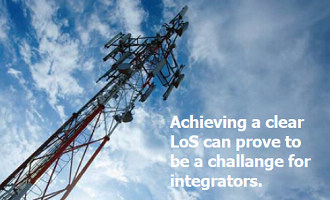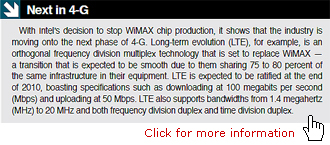Selecting proper elements to successfully integrate numerous devices using wireless media can be a daunting task. Careful planning and calculations are necessary to minimize setbacks.
Selecting proper elements to successfully integrate numerous devices using wireless media can be a daunting task. Careful planning and calculations are necessary to minimize setbacks.
Even after having placed much effort into planning out a system, it is inevitable some problems may still linger. Reliability is always a major concern. “Bandwidth is getting better with new technologies, but depending on the distance, weather, environment, quality and frame rate of the video needed, it still lacks in many areas,” said Patrick Lim, Sales and Marketing Director, Ademco Far East. “Insufficient bandwidth can either lead to disrupted streaming or degraded video quality. Bandwidth is less of an issue when dealing with alarm transmissions due to their very small data files.”
 “There is no real limit to size in terms of data streaming, but the larger it is, the longer it takes to transmit. In the case of video, there could be an issue with latency,” said Roy Cummings, Technical Support Manager, AMG Systems.
“There is no real limit to size in terms of data streaming, but the larger it is, the longer it takes to transmit. In the case of video, there could be an issue with latency,” said Roy Cummings, Technical Support Manager, AMG Systems.
Radio path planning tools are available for network engineers to plan the network path prior to installation. “These tools help determine the best locations to place transmitters and receivers for maximum performance, which helps combat the degradation expected whenever data is transmitted over airwaves during b r i e f periods of rain,” said Joe Schraml, VP of Marketing, BridgeWave Communications.
Also, when an antenna picks up a signal, it is amplified and filtered to get the best digital information. There is resilience built into the digital encoding, so data can be rebuilt in the case of data loss, said Guillaume Renaud, Customer and Sales Support Engineer, Octasic.
Even so, completely unobstructed radio paths are rare, and achieving line of sight (LoS) is always a major challenge for integrators. “Concrete structures in a city environment are always a problem for wireless transmission because they reduce the transmission distance. This is especially true for wireless video,” Lim said.
Signal boosters and repeaters are popular for strengthening signals and extending the distance between a transmitter and receiver. However, a booster amplifies both the signal and the noise, often leading to a wireless link with a high interference level. “If the range is not enough, then an antenna with a higher grain is the best way to go, since it only amplifies the signal, leaving the noise level untouched,” said Cosimo Malesci, VP of Marketing, Fluidmesh. “A higher signal to noise ratio will lead to a more reliable wireless infrastructure.”
SECURITY CONCERNS
 A top concern is the security of all data, and all transmissions should be encrypted to ensure there is no unauthorized, third-party access. “Many radio vendors employ encryption, and the strongest encryption algorithm currently available commercially is 256-AES,” Schraml said.
A top concern is the security of all data, and all transmissions should be encrypted to ensure there is no unauthorized, third-party access. “Many radio vendors employ encryption, and the strongest encryption algorithm currently available commercially is 256-AES,” Schraml said.
There are many encryption options that could satisfy a client's need for security. Another encryption algorithm is the S128. “It is one of the most robust encryption systems out there offered to networks, including applications towards the U.S. military and government,” Malesci said.
However, not all encryptions are available for the general public. “The ones with highest security tend not to be freely available because they are mostly reserved for military use,” Cummings said.
Authenticated routing is another way to secure data during transmission. “When two networks are placed next to each other, authenticated routing prevents them from sharing data,” Malesci said.
NOTABLE FACTORS
Prior to using wireless transmission for a project, a number of issues need to be considered. “The number of edge devices data is transmitted from, and the distance it is to be transmitted over are two important factors,” Cummings said.
Also, a wireless solutionis recommended only if there is no possibility of using wired cabling, such as an outlying camera feeding into a highway's network. Another issue is that wireless transmission may be influenced by environmental conditions, such as snow and rain, which can limit transmission distance or deteriorate signal quality by causing interference. Many wireless technologies further require LoS, which can be very difficult to achieve in compacted cities. Unlicensed frequencies are subject to sharing with other signals and users, which could further interfere with the transmission and signal quality, Cummings said.
 Picking the right devices often means balancing quality and budget. “The components themselves are very important,” said Michele Bonafede, Sales and Marketing Manager, VS Safety. “Contact well-known manufacturers and suppliers, and ask for references before any purchases. Also, products with the EN50.131 certification are reliable because it is approved by regulation bodies.” Time spent on researching pays off, since components may look good but begin to underperform in a short span of time.
Picking the right devices often means balancing quality and budget. “The components themselves are very important,” said Michele Bonafede, Sales and Marketing Manager, VS Safety. “Contact well-known manufacturers and suppliers, and ask for references before any purchases. Also, products with the EN50.131 certification are reliable because it is approved by regulation bodies.” Time spent on researching pays off, since components may look good but begin to underperform in a short span of time.
There are many medias to choose from, such as ZigBee, WiMAX, GSM and 3-G. New technologies are constantly being pushed into the scene — the latest one being 4-G. Each technology has its strengths and weaknesses, and it depends largely on the individual project when choosing the most suitable network. “ZigBee is great for cloud environments where there is no LoS but includes many devices close together. WiMAX, on the other hand, is similar to a backbone that covers very large areas,” Malesci said.
 Since clarity is a big concern, there are hardware solutions that can be built into access points to help filter out static. “They can classify the type of transmission application and automatically detect any interference and investigate it,” said Walt Shaw, Senior Product Line Manager, Wireless Networking Business Unit, Cisco Systems.
Since clarity is a big concern, there are hardware solutions that can be built into access points to help filter out static. “They can classify the type of transmission application and automatically detect any interference and investigate it,” said Walt Shaw, Senior Product Line Manager, Wireless Networking Business Unit, Cisco Systems.
Asides from video, other devices also require clear transmission paths. For example, hardware is built into access points to ensure clear communication from wireless locking devices.
A brand new system called MIMO came into the market last year. It is built directly into a device and has multiple radios and antennas, which allow for higher-capacity transmission and non-LoS reception. This new technology can expand the transmission bandwidth from 24 to 200 megabits for a small incremental cost compared to yesterdays technology,” said Geoffrey Smith, Senior VP of Sales for the Americas, Europe and Africa, Proxim Wireless. “It can also power the camera with its second ethernet port, simplifying installations."
OUTLOOK
Currently, wireless technology is being deployed all over the world. “We're seeing a lot of wireless projects in the U.S., South America, Europe and Africa. About 50 percent of the deployments in the U.S. are using wireless, and it is being used for almost all the projects in South America and Mexico. Trenching is a big issue for many countries, and South America, Mexico and Europe have chosen wireless over wired due to this,” Smith said.
A lot of base stations are being built, and there has been an uptake in the market for base station antennae in rural areas, said Renaud.
 There will be growth in the foreseeable future for wireless transmission. It was only a few years ago when 2-G was new to the market, illustrating the fast pace at which improvements are being made and how new solutions are constantly being sought after. 4-G will be expected to grow at a steady rate in the next couple of years.
There will be growth in the foreseeable future for wireless transmission. It was only a few years ago when 2-G was new to the market, illustrating the fast pace at which improvements are being made and how new solutions are constantly being sought after. 4-G will be expected to grow at a steady rate in the next couple of years.
Innovations are constantly being made. “The industry is looking for higher-throughput standards. 802.11n was only ratified in October 2009, and the next thing is already being developed. 802.11ac and 802.11ad are expected to come out sometime between 2012 and 2013,” Shaw said.
The progression of Wi-Fi and wireless networking is changing the face of access systems. "There are indicators that this market will grow exponentially," said David Rees, Regional Manager for APAC, Salto Systems.
In terms of wireless video, the growth will be modest, but stable. “There is an expected 10 to 15 percent growth, mainly because more technologies are being made available but are still restricted to nonurban deployments. The growth of wireless video transmission may depend on finding a niche application until newer technologies are introduced that can provide efficient and reliable video transmission in dense cities,” Lim said.
 Smart cities and smart grids are picking up speed. “There has not been too much money put into them yet, but they will definitely become big in the future. A smart grid is a smart energy network that yields billions in energy savings. This equals a smaller energy bill and a more environment-friendly future,” Malesci said. For example, in the city of Gutenberg, a law was passed where all energy consumption must be monitored. Thus, a ZigBee network was set up over the city, and automatic energy meter readings are sent back to the central station. Residents are also permitted to use the network for their own security devices for a small fee, Bonafede said.
Smart cities and smart grids are picking up speed. “There has not been too much money put into them yet, but they will definitely become big in the future. A smart grid is a smart energy network that yields billions in energy savings. This equals a smaller energy bill and a more environment-friendly future,” Malesci said. For example, in the city of Gutenberg, a law was passed where all energy consumption must be monitored. Thus, a ZigBee network was set up over the city, and automatic energy meter readings are sent back to the central station. Residents are also permitted to use the network for their own security devices for a small fee, Bonafede said.
There has been a lot of interest in wireless video conferencing. “HD video conferencing is becoming quite popular, but there are still some issues such as the channel count going down a lot more than mobile video,” Renaud said.
More interoperability will be possible among devices. “More companies are adopting open standards for their sensors, controls and security networks, and an increasing rate of installations is expected,” said Geoff Mulligan, Chairman of the IPSO Alliance. “Wireless adoption will increase at a faster pace than wired because of the ease of deployment, but wireless cannot replace a wired network for all situations. The vendor and customer must choose the most appropriate technology for the application and ensure that they can be integrated together seamlessly.”
However, it is important to keep in mind that all this growth will largely be dependent on governments opening up frequencies for data transmission, Schraml cautioned.